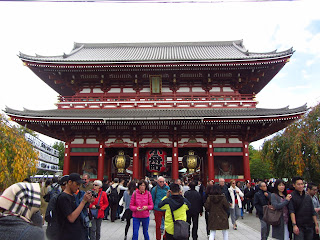One of the joys of travel is that sometimes I serendipitously discover all these links between the various destinations one visits. So for example, the day after our visit to Ieyasu Tokugawa’s grave in Nikko, we go visit Senso-Ji in Tokyo and discover that Ieyasu Tokugawa also made this temple (then already around 1000 years old as it was first opened in 645AD!) one of “his” two temples in Edo. Asakusa was then a small humble village, Edo, then a small town. Over the years, of course the temple has grown into one of the oldest and most visited Temples in all of Japan. And Edo has metamorphosed into Tokyo, one of the great global cities in the world. Ieyasu would be proud.
More on the history of Senso-Ji and on its grounds can be found on other sites, like this one and this one, so I will not go into it again here. I didn’t in any case feel compelled to go and look at every single thing listed on these sites - we were happy to just wander around the temple and its grounds, and in the process, discover its secrets (such as the free green tea).
 |
| The crowds at the Kaminarimon Gate |
Now as we were passing through the gate, we noticed this rather enthusiastic tourist. Often we see tourists all dressed up in Japanese kimono, the ladies all prettily decked out in floral kimono with their hair all done nicely, and the men in their duller outfits. But this particular chap was dressed as a Ninja, and doing his best to act like one - posing in “ninja” poses, hiding behind the lantern etc etc. Unfortunately I didn’t get a photo (too many people always in the way) but it was quite hilarious to see this ninja prancing around looking as conspicuous as possible (when one considers that the ninja is supposed to be blending into the shadows, disappearing into the night etc as they go about doing their secret work). In fact he was happy to pose for photos, including with the kimono-clad tourists who wanted to get a little extra out of their time in costume.
 |
| The second gate - the Hozomon Gate |
Next, we visited this little garden next to the main hall, a quiet spot after the bustle of the temple. There were many little shrines here (actually there are a number of shrines throughout the complex) each with its own little friendly statue awaiting visitors, some looking very weathered as their markings had faded over the years. This, more than anything, gives you the sense that indeed this is a very, very old temple...
For those interested, more photos of Senso-ji here.
 |
| Soba at Owariya Honten |
After lunch we made our way to Asakusa-bashi, the nearby “crafting district” of Tokyo. Here is where craft lovers - knitters, beaders, embroidery fans etc - find their Mecca, with numerous little shops all over the place. We were here to learn how to make tsumami flowers, which is the technique used to make these little flowers from Japanese crepe fabric (not a huge destructive tidal wave!). The flowers are assembled in various intricate beautiful ensembles to make up the elaborate headdresses (Kanzashi) of maikos and geishas. I had of course seen these when we were in Kyoto previously at the Gion Corner (as seen in these photos), and was instantly captivated.
The workshop is run by a Tsumami craft shop, Tsumamido, in a basement workshop next to the shop itself. We were the only two in our class where we made the petals and leaves and assembled it to form a flowery brooch. Not bad, for a first time? But nothing compared to those in Gion Corner or indeed those on this site.
 |
| My handiwork |
We went back to Shinjuku after this - walked around the shops, visited Isetan's food hall to buy some breakfast, etc etc. A slower pace compared to the long day trip to Nikko, but it enabled us to rest and recharge for the next day's activities!

No comments:
Post a Comment